
|
Now it is bright as 8.9 mag (May 21, Juan Jose Gonzalez). It stays bright as 9 mag for a while. In the Southern Hemisphere, it stays observable in good condition for a long time until the comet will fade out. In the Northern Hemisphere, it is observable only until June.
Date(TT) R.A. (2000) Decl. Delta r Elong. m1 Best Time(A, h)
May 26 19 25.19 -20 34.2 1.555 2.378 134 9.7 3:13 (180, 75)
June 2 19 13.94 -25 5.3 1.450 2.349 144 9.5 2:34 (180, 80)
|
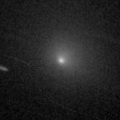
|
It brightened rapidly as expected. Now it is very bright as 10.2 mag (May 22, Chris Wyatt). It stays at 10-11 mag until June. In the Southern Hemisphere, it stays observable in excellent condition. In the Northern Hemisphere, it will be unobservable from April to June when the comet becomes brightest.
Date(TT) R.A. (2000) Decl. Delta r Elong. m1 Best Time(A, h)
May 26 23 34.16 -32 41.2 0.899 1.293 84 10.2 5:26 (273, 66)
June 2 23 57.70 -30 29.0 0.903 1.303 85 10.5 5:29 (266, 67)
|

|
Now it is 11.3 mag (May 15, Juan Jose Gonzalez). It stays bright as 11 mag for a long time until autumn. In the Southern Hemisphere, it is not observable for a long time after this. In the Northern Hemispehre, it stays observable for a long time until the comet fades out. But it stays very low until autumn.
Date(TT) R.A. (2000) Decl. Delta r Elong. m1 Best Time(A, h)
May 26 6 7.62 47 43.6 3.363 2.608 35 11.1 18:27 (140,-13)
June 2 6 24.52 48 45.0 3.394 2.614 33 11.2 18:25 (140,-15)
|
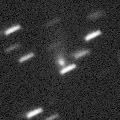
|
Now it is 14.4 mag (Apr. 8, Alexander Baransky). It will brighten up to 9 mag in summer. However, it is hardly observable when it is bright. In the Northern Hemisphere, it is not observable until late December. In the Southern Hemisphere, it is observable from July to September, but it locates in extremely low.
Date(TT) R.A. (2000) Decl. Delta r Elong. m1 Best Time(A, h)
May 26 3 32.53 22 46.2 2.271 1.280 8 11.9 5:26 (250,-12)
June 2 3 50.06 20 21.2 2.169 1.192 11 11.4 5:29 (250, -8)
|

|
Now it is 11.6 mag (May 15, Juan Jose Gonzalez). It stays 12 mag for a long time until spring in 2019. In the Northern Hemisphere, it stays observable in good condition for a long time, although it becomes unobservable temporarily from mid June to August. In the Southern Hemisphere, it is not observable until September.
Date(TT) R.A. (2000) Decl. Delta r Elong. m1 Best Time(A, h)
May 26 7 53.86 48 22.9 3.231 2.727 52 12.1 18:27 (154, -1)
June 2 7 57.44 45 47.1 3.308 2.713 46 12.2 18:25 (149, -1)
|
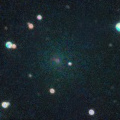
|
It brightened very rapidly. Now it is very bright as 11.8 mag (May 16, Juan Jose Gonzalez). It may fade out very rapidly in June. In the Northern Hemisphere, it stays observable until it fades out. It is not observable in the Southern Hemisphere.
Date(TT) R.A. (2000) Decl. Delta r Elong. m1 Best Time(A, h)
May 26 5 45.64 84 24.6 1.710 1.558 63 12.5 18:27 (174,-33)
June 2 5 19.94 84 9.6 1.754 1.563 62 13.3 18:25 (173,-34)
|

|
Now it is 14.8 mag (Apr. 26, Catalina Sky Survey). It will brighten rapidly after this, and it will brighten up to 11 mag from summer to autumn. It is observable in excellent condition in the Southern Hemisphere. It locates somewhat low in the Northern Hemisphere.
Date(TT) R.A. (2000) Decl. Delta r Elong. m1 Best Time(A, h)
May 26 21 44.83 -15 0.2 1.652 2.097 101 13.2 5:26 (184, 70)
June 2 21 55.04 -14 59.1 1.568 2.082 105 12.9 5:14 (180, 70)
|
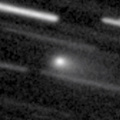
|
Now it is bright as 11.5 mag (May 16, Juan Jose Gonzalez). It will be observable at 12-13 mag in good condition from spring to summer.
Date(TT) R.A. (2000) Decl. Delta r Elong. m1 Best Time(A, h)
May 26 22 37.37 -12 12.3 1.304 1.625 88 13.0 5:26 (214, 64)
June 2 22 50.64 -10 9.4 1.265 1.635 91 13.1 5:29 (203, 63)
|
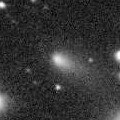
|
Now it is 14.4 mag (May 21, Toshihiko Ikemura, Hirohisa Sato). It will brighten rapidly, and brighten up to 7 mag from August to September. In the Northern Hemisphere, it will be observable in excellent condition. In the Southern Hemisphere, it will be unobservable from July to August. But it will be observable in good condition before and after tha.
Date(TT) R.A. (2000) Decl. Delta r Elong. m1 Best Time(A, h)
May 26 20 19.70 30 7.8 1.230 1.738 101 13.6 4:06 (180, 25)
June 2 20 30.94 33 47.7 1.145 1.673 101 13.1 3:50 (180, 21)
|

|
Now it is very bright as 12.0 mag (May 15, Juan Jose Gonzalez). It will be observable at 12-13 mag for a long time from 2017 to 2018. In the Southern Hemisphere, it will be hardly observable after this.
Date(TT) R.A. (2000) Decl. Delta r Elong. m1 Best Time(A, h)
May 26 12 42.71 55 1.7 3.652 3.826 92 13.2 20:26 (180, 0)
June 2 12 27.89 53 48.6 3.757 3.840 86 13.3 19:44 (180, 1)
|

|
Appearing in the morning sky. Now it is 14.8 mag (May 10, Toshihiko Ikemura, Hirohisa Sato).
Date(TT) R.A. (2000) Decl. Delta r Elong. m1 Best Time(A, h)
May 26 23 12.80 -0 35.4 5.950 5.782 75 13.6 5:26 (218, 49)
June 2 23 15.24 -0 10.2 5.843 5.781 81 13.5 5:29 (207, 52)
|
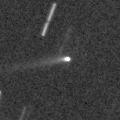
|
First return of a new periodic comet which brightened up to 13 mag in 2013. Now it is 16.3 mag (May 14, Toshihiko Ikemura, Hirohisa Sato). It will brighten very rapidly after this, up to 11 mag in summer. In the Southern Hemisphere, it stays observable in good condition all through this apparition. In the Northern Hemisphere, it is not observable at the high light from mid June to mid August.
Date(TT) R.A. (2000) Decl. Delta r Elong. m1 Best Time(A, h)
May 26 8 52.10 23 12.0 0.576 0.927 64 14.5 18:27 (152, 26)
June 2 8 55.99 19 34.8 0.522 0.876 59 13.6 18:25 (145, 27)
|
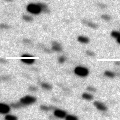
|
It is expected to approach to Sun down to 0.2 a.u. and brighten up to 3 mag in August. Now it is 16.4 mag (May 17, Toshihiko Ikemura, Hirohisa Sato). In the Northern Hemisphere, it stays observable in the morning sky until early August when the comet brightens up to 6 mag. It is not observable at all in the Southern Hemisphere.
Date(TT) R.A. (2000) Decl. Delta r Elong. m1 Best Time(A, h)
May 26 0 52.90 56 48.8 2.362 1.890 50 14.6 5:26 (205,-11)
June 2 1 12.47 57 31.5 2.222 1.771 51 14.2 5:29 (203,-10)
|
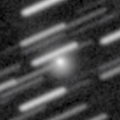
|
Now it is 14.8 mag (May 14, Toshihiko Ikemura, Hirohisa Sato). It will brighten up to 13 mag in 2019 spring. In the Northern Hemisphere, it stays observable in good condition for a long time. In the Southern Hemisphere, it locates extremely low until summer.
Date(TT) R.A. (2000) Decl. Delta r Elong. m1 Best Time(A, h)
May 26 18 49.66 46 34.8 3.581 3.940 103 14.7 2:37 (180, 8)
June 2 18 36.58 46 37.8 3.498 3.905 106 14.6 1:57 (180, 8)
|

|
The condition of this apparition is worst. It brightens up to 12.5 mag from April to May. But it is not observable at all.
Date(TT) R.A. (2000) Decl. Delta r Elong. m1 Best Time(A, h)
May 26 5 9.41 17 52.9 1.721 0.781 14 14.8 18:27 (109, -4)
June 2 5 48.54 18 18.1 1.782 0.863 16 15.8 18:25 (111, -2)
|

|
It brightened up to 7.1 mag from May to June in 2017 (June 21, Juan Jose Gonzalez). Now it is fading. It has already faded down to 14.6 mag (May 14, Thomas Lehmann). In the Southern Hemisphere, it stays observable for a long time after this. It will never be observable again in the Northern Hemisphere.
Date(TT) R.A. (2000) Decl. Delta r Elong. m1 Best Time(A, h)
May 26 1 28.27 -43 9.9 4.553 4.386 74 15.1 5:26 (298, 46)
June 2 1 35.50 -43 24.9 4.552 4.450 77 15.1 5:29 (298, 50)
|

|
Now it is 15.2 mag (May 21, Martin Masek). It stays 15 mag from 2018 to 2019, and it will be observable for a long time in the Southern Hemisphere. In the Northern Hemisphere, it will never be observable again.
Date(TT) R.A. (2000) Decl. Delta r Elong. m1 Best Time(A, h)
May 26 12 13.72 -67 27.6 3.874 4.481 121 15.2 19:58 ( 0, 57)
June 2 12 6.92 -67 1.4 3.874 4.453 118 15.1 19:24 ( 0, 58)
|

|
Now it is 17.2 mag (May 21, Martin Masek). It is observable at 15 mag in 2018, in good condition in the Southern Hemisphere. It locates somewhat low in the Northern Hemisphere.
Date(TT) R.A. (2000) Decl. Delta r Elong. m1 Best Time(A, h)
May 26 23 6.22 -15 43.9 3.062 3.107 83 15.7 5:26 (231, 62)
June 2 23 12.27 -15 27.7 2.981 3.119 88 15.6 5:29 (219, 66)
|

|
It brightened rapidly. Now it is 15.8 mag (May 14, Toshihiko Ikemura, Hirohisa Sato). It stays 15.5 mag until June.
Date(TT) R.A. (2000) Decl. Delta r Elong. m1 Best Time(A, h)
May 26 14 47.10 31 10.3 1.202 1.959 124 15.7 22:31 (180, 24)
June 2 14 44.63 27 42.8 1.209 1.957 123 15.7 22:01 (180, 28)
|
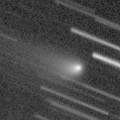
|
Appearing in the morning sky. It is fading now. But it stays 16 mag until summer. But actually, it is 18.1 mag (Mar. 23, Toshihiko Ikemura, Hirohisa Sato), fainter than this ephemeris.
Date(TT) R.A. (2000) Decl. Delta r Elong. m1 Best Time(A, h)
May 26 17 45.46 -27 57.7 2.896 3.850 157 15.9 1:34 (180, 83)
June 2 17 28.66 -28 12.5 2.902 3.898 167 15.9 0:50 (180, 83)
|
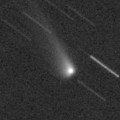
|
Now it is 17.2 mag (May 19, CAO, San Pedro de Atacama). Fading now. It stays observable in good condition for a long time after this in the Southern Hemisphere. It is not observable until June in the Northern Hemisphere.
Date(TT) R.A. (2000) Decl. Delta r Elong. m1 Best Time(A, h)
May 26 0 57.23 -8 58.1 4.953 4.467 56 16.0 5:26 (252, 38)
June 2 0 58.77 -9 46.9 4.860 4.484 62 15.9 5:29 (247, 44)
|

|
Now it is 15.5 mag (Mar. 16, iTelescope Observatory, Siding Spring). In the Southern Hemisphere, it stays observable until August, but it will be unobservable after that. In the Northern Hemisphere, it stays unobservable until June, but it will be observable in good condition after that. Its cometary activity was observed on Mar. 26 (M. Mommert, D. Polishook, N. Moskovitz).
Date(TT) R.A. (2000) Decl. Delta r Elong. m1 Best Time(A, h)
May 26 0 51.90 -6 31.4 1.513 1.263 55 16.0 5:26 (249, 37)
June 2 1 7.04 -2 23.4 1.510 1.283 57 16.1 5:29 (242, 38)
|

|
Now it is 20.7 mag (May 25, J. V. Scotti). It will brighten rapidly, and it is expected to brighten up to 10 mag in autumn. But actually, it is much fainter than this ephemeris. It will be observable in excellent condition in the Northern Hemisphere. It stays low in the Southern Hemisphere.
Date(TT) R.A. (2000) Decl. Delta r Elong. m1 Best Time(A, h)
May 26 22 29.31 -7 40.8 2.069 2.276 88 16.4 5:26 (206, 60)
June 2 22 39.09 -6 14.5 1.939 2.222 92 16.1 5:29 (195, 60)
|
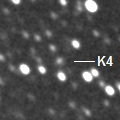
|
Now it is 17.2 mag (May 21, Toshihiko Ikemura, Hirohisa Sato). It was observed at 16 mag from summer to autumn in 2017. It will be observable at 16.5 mag in good condition also in 2018. It locates somewhat low in the Southern Hemisphere.
Date(TT) R.A. (2000) Decl. Delta r Elong. m1 Best Time(A, h)
May 26 0 16.23 14 39.2 3.433 2.982 55 16.4 5:26 (224, 28)
June 2 0 24.43 16 6.4 3.392 3.014 59 16.4 5:29 (218, 30)
|

|
Now it is 15.9 mag (May 4, Kunihiro Shima). It will be fading slowly until summer.
Date(TT) R.A. (2000) Decl. Delta r Elong. m1 Best Time(A, h)
May 26 11 23.17 11 42.2 3.204 3.561 102 16.5 19:08 (180, 43)
June 2 11 25.77 11 9.5 3.304 3.564 96 16.5 18:43 (180, 44)
|
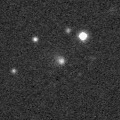
|
Unexpectedly, it brightened rapidly. Now it is 16.6 mag (May 15, Toshihiko Ikemura, Hirohisa Sato). It stays at 16.5 mag until July.
Date(TT) R.A. (2000) Decl. Delta r Elong. m1 Best Time(A, h)
May 26 12 22.98 1 46.2 1.430 2.126 120 16.5 20:08 (180, 53)
June 2 12 27.20 1 45.2 1.482 2.112 114 16.5 19:45 (180, 53)
|
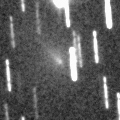
|
It brightened up to 15-16 mag in winter. Appearing in the morning sky. It stays observable at 16.5 mag for a while. It will be observable in good condition after this in the Southern Hemisphere. But it stays low in the Northern Hemisphere.
Date(TT) R.A. (2000) Decl. Delta r Elong. m1 Best Time(A, h)
May 26 22 31.47 -14 29.8 1.662 1.951 90 16.5 5:26 (213, 66)
June 2 22 18.41 -18 14.0 1.546 2.007 101 16.5 5:29 (187, 73)
|

|
Now it is 16.9 mag (May 15, Toshihiko Ikemura, Hirohisa Sato). It will be fainter than 18 mag in summer.
Date(TT) R.A. (2000) Decl. Delta r Elong. m1 Best Time(A, h)
May 26 14 36.00 -7 36.7 5.510 6.433 153 16.8 22:20 (180, 63)
June 2 14 33.45 -6 49.6 5.585 6.453 146 16.8 21:50 (180, 62)
|

|
Now it is 16.6 mag (May 10, Toshihiko Ikemura, Hirohisa Sato). It will be fading slowly after this.
Date(TT) R.A. (2000) Decl. Delta r Elong. m1 Best Time(A, h)
May 26 10 20.35 9 16.7 9.627 9.664 89 16.8 18:27 (172, 46)
June 2 10 21.84 9 18.8 9.746 9.669 82 16.8 18:25 (164, 44)
|

|
Now it is 16.7 mag (May 13, Hidetaka Sato). It will brighten rapidly after this, and it is expected to brighten up to 9 mag from autumn to winter. In the Northern Hemisphere, it stays observable in good condition for a long time until it fades out. In the Southern Hemispehre, it is observable in good condition until autumn, but it will be low in winter.
Date(TT) R.A. (2000) Decl. Delta r Elong. m1 Best Time(A, h)
May 26 1 23.19 -7 18.2 3.096 2.562 49 17.2 5:26 (255, 32)
June 2 1 35.52 -6 11.7 2.979 2.503 52 16.8 5:29 (251, 35)
|
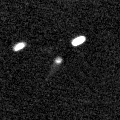
|
Now it is 16.7 mag (May 10, Toshihiko Ikemura, Hirohisa Sato). It will brighten up to 15 mag in January, 2019. It stays observable in excellent condition in the Northern Hemispehre. It is observable only until June in the Southern Hemisphere.
Date(TT) R.A. (2000) Decl. Delta r Elong. m1 Best Time(A, h)
May 26 10 35.26 34 41.1 3.915 3.925 83 16.9 18:27 (178, 20)
June 2 10 31.40 34 50.9 4.005 3.890 76 16.9 18:25 (172, 20)
|

|
Now it is 16.8 mag (May 15, Toshihiko Ikemura, Hirohisa Sato). It will be fading gradually after this, and it will be fainter than 18 mag in winter. In the Northern Hemisphere, it stays observable in good condition for a long time. In the Southern Hemisphere, it will never be observable again.
Date(TT) R.A. (2000) Decl. Delta r Elong. m1 Best Time(A, h)
May 26 23 17.38 70 37.2 7.587 7.212 64 16.9 5:26 (188,-17)
June 2 23 24.49 71 22.9 7.598 7.235 65 16.9 5:29 (186,-17)
|
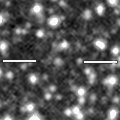
|
Now it is 18.0 mag (May 15, Toshihiko Ikemura, Hirohisa Sato). It stays observable at 17 mag in good condition from spring to autumn.
Date(TT) R.A. (2000) Decl. Delta r Elong. m1 Best Time(A, h)
May 26 21 1.08 0 40.8 5.634 5.990 105 17.2 4:48 (180, 54)
June 2 21 1.89 1 3.1 5.538 5.989 111 17.2 4:21 (180, 54)
|

|
Now it is 17.8 mag (May 15, Toshihiko Ikemura, Hirohisa Sato). It will be fading after this, and it will be fainter than 18 mag in July.
Date(TT) R.A. (2000) Decl. Delta r Elong. m1 Best Time(A, h)
May 26 11 23.38 26 58.8 5.619 5.807 95 17.5 19:08 (180, 28)
June 2 11 21.65 27 13.2 5.764 5.834 88 17.6 18:39 (180, 28)
|
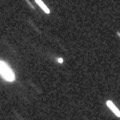
|
Now it is 17.3 mag (May 15, Toshihiko Ikemura, Hirohisa Sato). It will be fading gradually after this.
Date(TT) R.A. (2000) Decl. Delta r Elong. m1 Best Time(A, h)
May 26 10 35.64 34 55.0 8.425 8.365 83 17.7 18:27 (179, 20)
June 2 10 35.06 34 13.2 8.554 8.386 77 17.7 18:25 (173, 20)
|

|
It brightened up to 9.2 mag from November to December (Nov. 16, Juan Jose Gonzalez). Now it is fading rapidly. It has already faded down to 18.5 mag (May 15, Toshihiko Ikemura, Hirohisa Sato).
Date(TT) R.A. (2000) Decl. Delta r Elong. m1 Best Time(A, h)
May 26 13 31.89 3 11.3 1.552 2.374 134 17.7 21:16 (180, 52)
June 2 13 31.32 2 21.3 1.660 2.422 128 18.1 20:48 (180, 53)
|

|
Now it is 16.6 mag (May 15, Toshihiko Ikemura, Hirohisa Sato). It is observable at 17 mag in good condition in spring.
Date(TT) R.A. (2000) Decl. Delta r Elong. m1 Best Time(A, h)
May 26 12 44.27 -8 48.4 1.772 2.536 129 17.8 20:29 (180, 64)
June 2 12 46.56 -8 41.5 1.841 2.538 122 17.9 20:04 (180, 64)
|

|
Now it is bright as 18.0 mag (May 14, Hidetaka Sato). Hidetaka Sato pointed out its cometary activity. In the Northern Hemisphere, it stays observable at 18 mag until June. It is not observable in the Southern Hemisphere.
Date(TT) R.A. (2000) Decl. Delta r Elong. m1 Best Time(A, h)
May 26 7 31.33 40 12.4 1.956 1.460 46 17.9 18:27 (146, 3)
June 2 7 45.12 42 54.8 2.003 1.452 43 17.9 18:25 (146, -1)
|
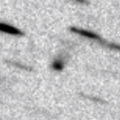
|
Now it is 17.7 mag (May 23, Martin Masek). It stays 18 mag from 2018 to 2020. It is observable in good condition in the Southern Hemisphere. It locates extremely low in the Northern Hemisphere.
Date(TT) R.A. (2000) Decl. Delta r Elong. m1 Best Time(A, h)
May 26 12 16.44 -35 32.5 3.809 4.496 127 17.9 20:01 ( 0, 89)
June 2 12 15.76 -35 1.9 3.873 4.492 121 18.0 19:33 ( 0, 90)
|
|
![]()
 C/2015 V2 ( Johnson )
C/2015 V2 ( Johnson ) C/2017 B3 ( LINEAR )
C/2017 B3 ( LINEAR ) 65P/Gunn
65P/Gunn C/2018 C2 ( Lemmon )
C/2018 C2 ( Lemmon ) C/2015 VL62 ( Lemmon-Yeung-PanSTARRS )
C/2015 VL62 ( Lemmon-Yeung-PanSTARRS ) C/2015 V1 ( PanSTARRS )
C/2015 V1 ( PanSTARRS ) (3552) Don Quixote
(3552) Don Quixote 64P/Swift-Gehrels
64P/Swift-Gehrels C/2017 K4 ( ATLAS )
C/2017 K4 ( ATLAS ) 74P/Smirnova-Chernykh
74P/Smirnova-Chernykh 105P/Singer Brewster
105P/Singer Brewster C/2017 S6 ( Catalina )
C/2017 S6 ( Catalina ) C/2017 E3 ( PanSTARRS )
C/2017 E3 ( PanSTARRS ) C/2014 B1 ( Schwartz )
C/2014 B1 ( Schwartz ) 38P/Stephan-Oterma
38P/Stephan-Oterma C/2018 A3 ( ATLAS )
C/2018 A3 ( ATLAS ) C/2014 OE4 ( PanSTARRS )
C/2014 OE4 ( PanSTARRS ) C/2017 M5 ( TOTAS )
C/2017 M5 ( TOTAS ) C/2017 D3 ( ATLAS )
C/2017 D3 ( ATLAS ) C/2014 R3 ( PanSTARRS )
C/2014 R3 ( PanSTARRS ) 62P/Tsuchinshan 1
62P/Tsuchinshan 1 143P/Kowal-Mrkos
143P/Kowal-Mrkos 2018 EN4
2018 EN4 186P/Garradd
186P/Garradd![]()

































